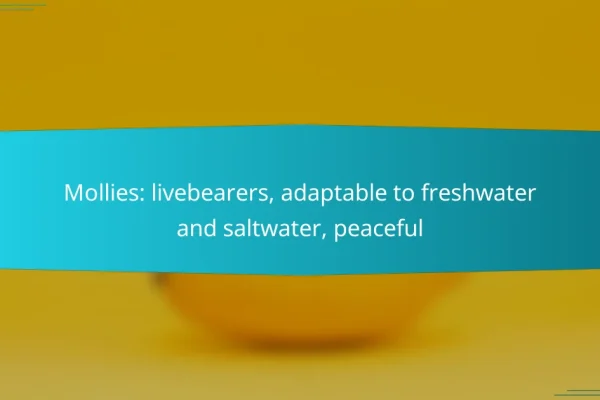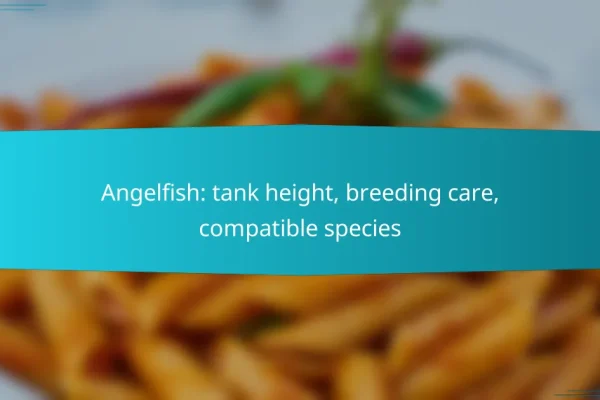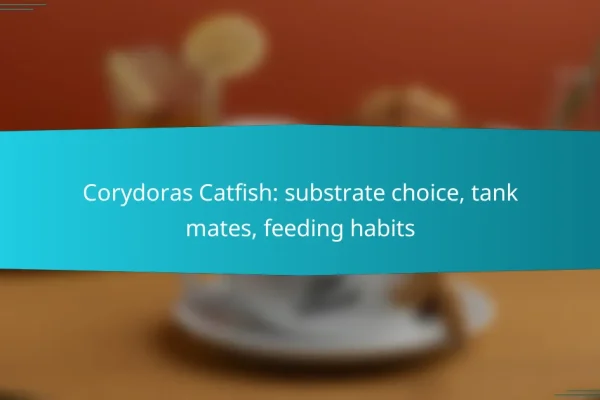
Mollies: livebearers, adaptable to freshwater and saltwater, peaceful
Mollies are versatile livebearers known for their adaptability to both freshwater and saltwater environments. These…
Choosing the right aquarium fish types is crucial for both beginners and experienced aquarists. Hardy species like Betta fish, Goldfish, and Guppies are ideal for those starting out, as they thrive in various conditions and add vibrant colors to your tank. Proper setup and care, including maintaining water quality and providing a balanced diet, are essential for ensuring a healthy aquatic environment.

Mollies are versatile livebearers known for their adaptability to both freshwater and saltwater environments. These peaceful fish are ideal for aquarists of all levels, thriving in stable conditions and cohabiting well with other species. Proper care, including suitable water conditions and a balanced diet, is essential for their health and well-being. How to care for…

Discus fish are known for their striking appearance and require a carefully balanced diet that includes high-quality pellets, frozen or live foods, and some vegetable matter to maintain their health and vibrant colors. To thrive, they need optimal water quality, with specific attention to temperature, pH levels, and regular maintenance. Additionally, selecting compatible tank mates…

Platies are vibrant and hardy fish that require specific care to thrive in an aquarium setting. Regular tank maintenance, including water changes and monitoring parameters, is essential for their health. Additionally, a consistent feeding schedule of small meals two to three times a day ensures they receive the necessary nutrition. For those interested in breeding…

Barbs are vibrant and social fish that require specific tank conditions to thrive, including warm temperatures, appropriate pH levels, and adequate tank size. Their omnivorous diet benefits from a variety of foods, including high-quality flakes and live options, along with vegetable matter. When selecting tank mates, it’s important to choose species with similar temperaments to…

Barbs are lively and active swimmers, making them a popular choice for home aquariums. Known for their strong schooling behavior, these fish thrive in groups, adding dynamic movement and energy to any tank. However, some species can exhibit aggressive tendencies, necessitating careful selection of tank mates and appropriate environmental conditions to ensure a harmonious community….

Angelfish thrive best in tanks that are at least 20 inches tall, allowing them ample swimming space and promoting healthy behavior. Breeding these fish requires careful attention to their specific needs and creating an optimal environment for successful reproduction. Additionally, selecting compatible species for a community tank is crucial, as peaceful and similarly sized tank…

Corydoras Catfish thrive in aquariums with soft substrates like fine sand, which protects their sensitive barbels while allowing natural foraging behaviors. They are social creatures that prefer peaceful tank mates, making it important to choose compatible species that share similar water conditions. A balanced diet of high-quality sinking pellets, along with occasional live or frozen…

Angelfish are beautiful and popular aquarium fish, but they can exhibit aggression if not properly managed. To promote harmony, it’s crucial to create a balanced environment with adequate space and hiding spots, as well as to choose compatible tank mates. Additionally, maintaining optimal water quality and implementing disease prevention strategies are vital for keeping angelfish…

Siamese Fighting Fish, or Betta fish, are renowned for their stunning colors and elaborate fins, making them a popular choice among aquarists. However, male Bettas are known for their aggressive behavior, particularly towards other males, which necessitates a solitary lifestyle. Understanding their unique needs is crucial for successful care and maintenance. How to care for…

Zebra Danios are lively and social fish that thrive in a well-maintained aquarium environment. A minimum tank size of 10 gallons is recommended, with larger tanks providing better water quality and ample swimming space. To ensure their health, it’s essential to monitor water parameters and perform regular maintenance, while keeping them in groups enhances their…
The best aquarium fish types for beginners are those that are hardy, easy to care for, and adaptable to various water conditions. Fish like Betta fish, Goldfish, Guppies, Zebra Danios, and Neon Tetras are popular choices due to their resilience and vibrant colors.
Betta fish, also known as Siamese fighting fish, are ideal for beginners due to their striking appearance and relatively simple care requirements. They thrive in smaller tanks, typically around 5 gallons, and prefer warm water temperatures between 76°F and 82°F.
When keeping Betta fish, avoid housing them with aggressive species or other male Bettas to prevent fighting. Provide plenty of hiding spots and plants to create a comfortable environment.
Goldfish are classic aquarium fish that are easy to care for and can live for many years with proper attention. They require a minimum tank size of 20 gallons, as they produce a significant amount of waste, necessitating good filtration and regular water changes.
Keep in mind that Goldfish can grow quite large, so plan for their long-term needs. They prefer cooler water temperatures, ideally between 65°F and 75°F.
Guppies are colorful, lively fish that are perfect for beginners. They are small, typically around 1-2 inches long, and can thrive in a variety of water conditions. A tank of at least 10 gallons is recommended for a small group of Guppies.
These fish are livebearers, meaning they give birth to live young, so be prepared for potential breeding. Providing plenty of plants and hiding spots will help manage their population and create a comfortable habitat.
Zebra Danios are hardy fish that adapt well to various environments, making them excellent for novice aquarists. They are active swimmers and prefer a tank of at least 10 gallons with a temperature range of 65°F to 75°F.
These fish are social and should be kept in groups of at least five to prevent stress. They are also known for their resilience, making them a great choice for community tanks.
Neon Tetras are small, vibrant fish that add a splash of color to any aquarium. They thrive in schools of six or more and prefer a tank size of at least 10 gallons with a temperature between 70°F and 81°F.
These fish are peaceful and do well in community tanks with other non-aggressive species. Providing plants and hiding spots will help them feel secure and reduce stress in the aquarium environment.
Setting up an aquarium for tropical fish involves creating a suitable environment that mimics their natural habitat. Key steps include selecting the right tank size, installing a filtration system, adding substrate and decorations, and maintaining the proper water temperature.
The tank size is crucial for the health of your tropical fish. A larger tank, typically at least 20 gallons, provides a more stable environment and allows for a greater variety of fish. Smaller tanks can lead to rapid fluctuations in water quality, which can stress fish.
Consider the number and type of fish you plan to keep, as some species require more space than others. A good rule of thumb is to allow one inch of fish per gallon of water, but this can vary based on the species' needs.
A reliable filtration system is essential for maintaining clean and healthy water in your aquarium. It helps remove waste, uneaten food, and harmful chemicals, ensuring a stable environment for your fish. Choose a filter that is appropriate for the size of your tank and the type of fish you have.
Consider using a filter with both mechanical and biological filtration capabilities. Mechanical filters remove particles from the water, while biological filters promote beneficial bacteria that break down harmful substances.
Substrate and decorations enhance the aesthetic appeal of your aquarium and provide hiding spots for fish. Use aquarium-safe gravel or sand as substrate, ensuring it is suitable for the species you keep. A depth of 1-2 inches is generally sufficient.
Decorations like rocks, plants, and driftwood not only beautify the tank but also create territories for fish, reducing stress. Ensure all decorations are free from sharp edges and safe for aquatic life.
Maintaining the correct water temperature is vital for the well-being of tropical fish. Most tropical species thrive in temperatures between 75°F and 80°F (24°C to 27°C). Use a reliable aquarium heater to keep the water within this range.
Regularly monitor the water temperature with a thermometer and adjust the heater as needed. Sudden temperature changes can shock fish, so make adjustments gradually to avoid stress.
Essential care tips for freshwater fish include maintaining water quality, providing a balanced diet, and ensuring the tank is not overcrowded. These practices help create a healthy environment that supports the well-being of your fish.
Regular water changes are crucial for maintaining a healthy aquarium. Aim to change 10-20% of the water weekly to remove toxins and replenish essential minerals. This practice helps prevent the buildup of harmful substances that can stress or harm your fish.
When performing water changes, use a water conditioner to eliminate chlorine and chloramines. Always match the temperature of the new water to that of the tank to avoid shocking your fish.
Monitoring water parameters is vital for the health of your freshwater fish. Key parameters include pH, ammonia, nitrite, and nitrate levels. Use a reliable test kit to check these levels regularly, ideally once a week.
For most freshwater fish, pH levels should be between 6.5 and 7.5, while ammonia and nitrite levels should be at 0 ppm. Nitrate levels should be kept below 20 ppm to ensure a safe environment.
Feeding your fish an appropriate diet is essential for their growth and health. Provide a varied diet that includes high-quality flakes, pellets, and occasional live or frozen foods. This variety ensures that your fish receive all necessary nutrients.
Be mindful of portion sizes; feed only what your fish can consume in a few minutes to avoid overfeeding, which can lead to water quality issues. Adjust the diet based on the specific needs of different species in your aquarium.
Preventing overstocking is crucial for maintaining a balanced aquarium ecosystem. A general rule of thumb is to allow one inch of fish per gallon of water, but this can vary based on species and their specific needs.
Overstocking can lead to increased waste, poor water quality, and stressed fish. Regularly assess your tank's population and consider upgrading to a larger tank or finding new homes for some fish if necessary.
Choosing compatible fish species involves understanding their behavior, tank requirements, and social needs. Selecting the right combinations can prevent stress and aggression, ensuring a harmonious aquarium environment.
Different fish species exhibit varied behaviors that can significantly impact their compatibility. For instance, some fish are territorial, while others are more social and thrive in groups. Researching each species' temperament helps avoid conflicts in the tank.
Look for resources that detail the natural habitats and social structures of the fish you are considering. This knowledge will guide you in selecting species that can coexist peacefully.
The size of your aquarium plays a crucial role in determining which fish species can live together. Larger tanks provide more space for fish to establish territories, reducing stress and aggression. A general guideline is to allow at least one gallon of water per inch of fish.
For example, if you plan to keep a group of small tetras, a 20-gallon tank would be suitable for a school of six to eight fish. Always remember that overcrowding can lead to poor water quality and increased competition for resources.
Many fish species are social and prefer to be in groups, which enhances their well-being. Species like guppies and danios thrive in schools, while solitary fish may become stressed if kept alone. It's essential to keep these social fish in appropriate numbers to mimic their natural environment.
A good rule of thumb is to keep at least five to six individuals of social species to ensure they feel secure and exhibit natural behaviors. Avoid mixing too many different species in one tank, as this can lead to stress and aggression among the fish.
Signs of fish illness can manifest in various ways, indicating potential health issues. Recognizing these symptoms early can help prevent further complications and ensure the well-being of your aquarium fish.
Behavioral changes are often the first indicators of illness in fish. Look for signs such as lethargy, unusual swimming patterns, or hiding more than usual. Healthy fish typically exhibit active and social behavior, so any significant deviations should prompt further investigation.
Common behavioral changes include fish staying at the bottom of the tank, not interacting with tank mates, or excessive rubbing against objects. Monitoring these behaviors regularly can help catch illnesses early.
Visible lesions on a fish's body can signal various health problems, including infections or parasites. Check for any unusual spots, discoloration, or swelling on the skin, fins, or gills. These physical signs can indicate bacterial infections or external parasites that require immediate attention.
Lesions may appear as white spots, red patches, or open sores. If you notice any of these symptoms, consider isolating the affected fish and consulting a veterinarian or an aquarium specialist for appropriate treatment options.
A loss of appetite is a significant warning sign that your fish may be unwell. Healthy fish typically eat regularly, so a sudden refusal to eat can indicate stress, illness, or environmental issues. Monitor feeding habits closely to identify any changes.
Factors such as water quality, temperature, and tank mates can influence a fish's willingness to eat. If a fish stops eating for more than a couple of days, it's essential to assess the tank conditions and seek professional advice if necessary.